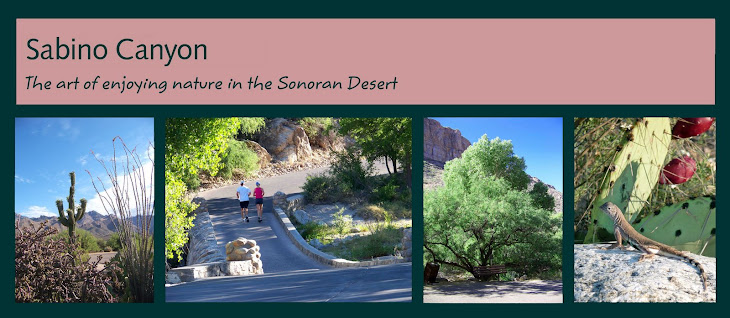But perhaps the most outstanding feature of creosotes is their longevity in harsh desert climates. Individual plants can live 100 to 200 hundred years, and the plant often clones itself. The oldest known ring of creosote clones, named King Clone, is 11,700 years old and lives in the Mojave Desert. The creosotes pictured here are all in the Sonoran Desert at Sabino Canyon.
 Creosotes are extremely heat and drought tolerant and can survive for two years without water. A sticky resin coating on small leaves helps the plant to conserve moisture. In hot weather, pairs of leaves fold together lessening exposure to the sun. And, on extremely hot days, the creosote might drop some of its leaves to further cut down on water loss.
Creosotes are extremely heat and drought tolerant and can survive for two years without water. A sticky resin coating on small leaves helps the plant to conserve moisture. In hot weather, pairs of leaves fold together lessening exposure to the sun. And, on extremely hot days, the creosote might drop some of its leaves to further cut down on water loss. Small yellow flowers bloom mostly in the spring, but can appear throughout the year following rain. The delicate flowers have five petals which are twisted slightly like fan blades.
Small yellow flowers bloom mostly in the spring, but can appear throughout the year following rain. The delicate flowers have five petals which are twisted slightly like fan blades. Pea-sized fuzzy fruits eventually split into five sections and fall to the ground.
Pea-sized fuzzy fruits eventually split into five sections and fall to the ground. Most wild grazing animals don't like the taste of creosote plants and avoid eating them, but the shrub is important to smaller desert wildlife. Reptiles and rodents live in burrows under the canopy of the plant. Bees feed on the flowers. A small gnat-like insect, named creosote gall midge, creates walnut-sized outgrowths at the tips of plant stems. The creosote midge larvae live inside the gall and don't seem to bother the plant too much.
Most wild grazing animals don't like the taste of creosote plants and avoid eating them, but the shrub is important to smaller desert wildlife. Reptiles and rodents live in burrows under the canopy of the plant. Bees feed on the flowers. A small gnat-like insect, named creosote gall midge, creates walnut-sized outgrowths at the tips of plant stems. The creosote midge larvae live inside the gall and don't seem to bother the plant too much. Besides creosote gall midges, there are also creosote grasshoppers and walkingsticks. We found this creosote walkingstick on a juniper in our yard.
Besides creosote gall midges, there are also creosote grasshoppers and walkingsticks. We found this creosote walkingstick on a juniper in our yard. Creosote bushes sometimes provide shade and shelter to young cacti the way mesquite trees often do. Below is a creosote acting as a nurse plant for a barrel cactus.
Creosote bushes sometimes provide shade and shelter to young cacti the way mesquite trees often do. Below is a creosote acting as a nurse plant for a barrel cactus. Splashing the landscape with bright green color, creosotes make it hard to resist taking a stroll among them.
Splashing the landscape with bright green color, creosotes make it hard to resist taking a stroll among them.




 Creosotes undoubtedly have important lessons to teach about acceptance, tolerance, determination, and purpose, but for now it seems like enough to simply enjoy and admire their presence.
Creosotes undoubtedly have important lessons to teach about acceptance, tolerance, determination, and purpose, but for now it seems like enough to simply enjoy and admire their presence.

This post was an overload of beautiful pictures and beautiful words describing them! The creosote walking stick was stunning! I had never seen an insect that looked so much like a wooden stick!
ReplyDeleteI am so glad I found your blog.
The top one would make a really nice painting.
ReplyDeletehttp://racheteapaintersdiary.blogspot.com/
wow that was a great read, thanks!
ReplyDeleteDiane, this is one of my favorite of the Sonoran Desert plants! The scent after a rain is unlike anything else---so FRESH. It's even better than the smell of newly cut grass. ;)
ReplyDeleteI just love how informative you are. I'd not know about their longevity! Now this favorite is even more special, and I can't wait to tell my neighbors.
Thanks so much!
Absolutely gorgeous photos and information that I didn't know. Thanks. I love their little yellow flowers.
ReplyDeleteI keep forgetting to say how lucky you are (read I am jealous) that you can spend so much time in the beautiful Sabino Canyon!
ReplyDeleteThis is a very educational piece for me, and the pictures are just gorgeous, Diane!
ReplyDeleteGreat, great, great post!
I love this, and the pictures are so wonderful.
ReplyDeleteI've come to love creosote for its fragrance and its color. It's a brighter green than most desert plants and it's green year round. I almost considered trying to make a wreath from some at Christmas time but never got around to it. I was too busy blogging!
ReplyDeleteThey certainly are a good example to follow! Thanks for introducing Creostoes to me. During our three-year drought here, I should have known about them sooner.
ReplyDeletemarvelous blog celebrating the subtle beauty of the desert. I so much enjoy this type of nature.
ReplyDeletemy in-laws lived in Tucson for a couple of years at Del Webbs Sun City 15 yrs ago. We just loved vising there.